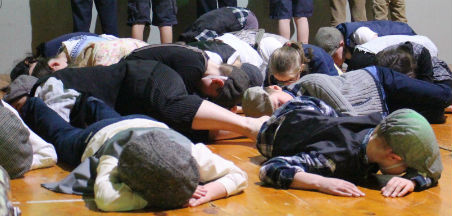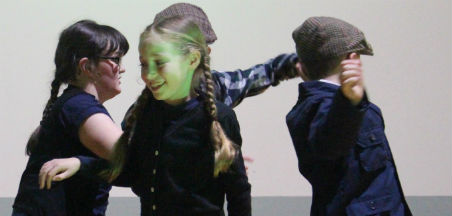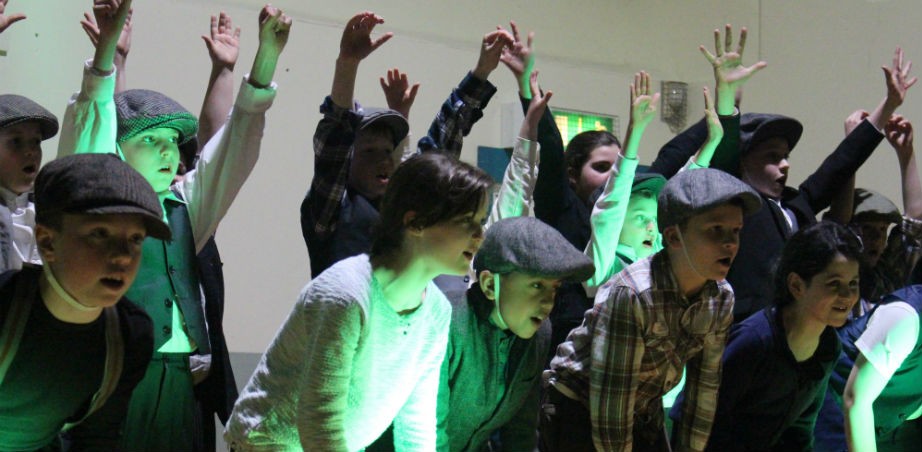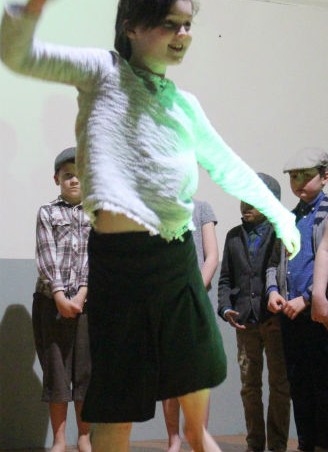Refine by Region
Refine by Art Form
Refine by School Level
The Easter Rising Dance Project
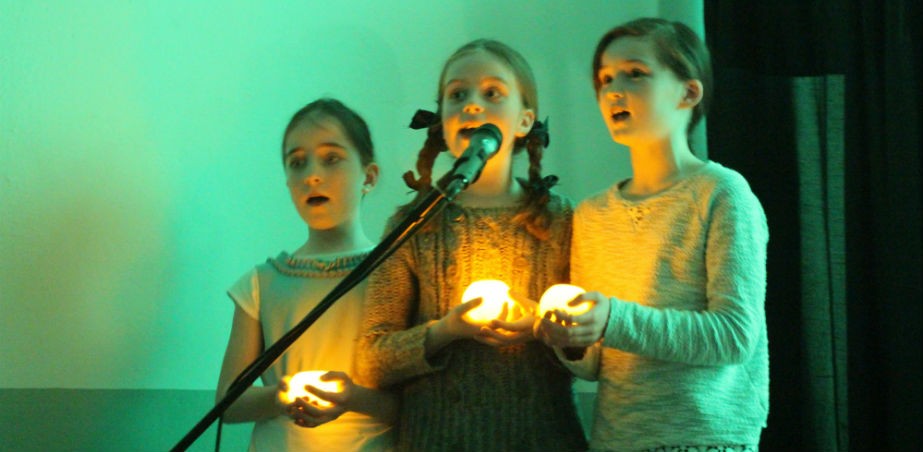
Tell us the story of your project – What was it about? Who was involved? How did you begin?
Maria Svensson, Artist
It all started when Marie and I met during the Department of Education & Skills’ summer programme of Continuing Professional Development (CPD). This summer course was one element in a wider exploration of Teacher/Artist Partnership as a model of CPD for enhancing and supporting arts education in the Primary school.
When course finished we decided to apply for funding for a partnership project to facilitate us to apply the course learning in practice. An application to the Kerry County Council 1916 Commemoration Fund was considered and discussions took place with The Education Centre, Tralee, on how we might progress this. The teacher had been nominated by The Education Centre and I had been nominated by the Arts Office of Kerry County Council.
Our aim was to work with the 3rd class at Ardfert National School, focusing on the students’ enjoyment of movement and their ability to express themselves freely through movement and dance whilst exploring the history of the Easter Rising. Moreover we wanted this work to culminate in a public showing, i.e. a dance performance. Finally, our aim was to develop teacher competence and confidence around dance.
The development of children and teachers through this art form using a Partnership approach was supported by The Education Centre, Tralee and Kerry County Council. Marie and I scheduled a workshop with the school’s Principal and staff in Ardfert NS to incentive and introduce the project. We began to plan the initiative and set out the objectives for teacher, artist and student learning. We also started planning what to do with the students, where and when we would meet, where the performance could take place etc. I had 10 sessions with the students, each lasting 2 hours. For some part of that time, the students would write in their reflective journals while Marie and I would have a chance to talk about what to do next or reflect ourselves on how things were going.
Marie O’Connell, Teacher
As the teacher, I felt that this initiative presented a great opportunity for the pupils to work with a dance artist and experience the art of dance. They did not have such an opportunity previous to this. I also felt it would be a great opportunity to support my own continuous professional development, to deepen my knowledge of the art of dance and to learn how to approach a theme through the art form.
The use of reflective journaling by the children was most revealing as it provided insight into the childrens’ learning journey within the context of the initiative and captured some of the impact and response. The journals contained written and pictorial reflections on the development of the project. In this way it introduced the children to the notion of reflective practice and the sharing of those reflections developing their skill and knowledge base.
How were the ideas developed and how did the young people, artist and teacher work together?
Maria Svensson, Artist
After the workshop with the Principal and teachers it was decided that the school would organise a concert in the community centre, where other students could perform as well. The theme throughout would be The Easter Rising.
During the first couple of sessions with Marie’s class, I aimed at getting to know the students and exposing them to different movement exercises. Marie laid the groundwork, looking at the history around the time of The Rising and how people lived then. She introduced a folder with gathered stories about The Rising aimed at 3rd-4th class. I received a copy of this myself and knew then what the students were learning with regards to the theme. In the dance and movement classes I would look at expressing emotions related to stories and images from that time. I did not want to teach the students moves they would copy and learn off by heart. Instead, I used ways of working so the movements would come from the students themselves. They were very willing and creative and gained confidence as we went along. One of the teachers in the school recommended music for us and helped practice with the students. We decided the students would start and end the piece by singing Mise Éire and there was another song called Fionnghuala, which they would sing in the middle of the piece. Ideas were developed as the project went along, such as duration, costume, format etc. The music found its place, as did the various movement tasks we had been working on, such as phrasing, moving like statues etc. In the lead up to the performance, Marie would practice the piece with the students outside the set dance classes to give them a chance to remember where to go and what to do next. Marie would join in the exercises and tasks, when she wasn’t managing the video camera, and her presence was extremely beneficial for the students as they saw this class was to be taken seriously, just like any other class. Marie also supported the students in writing their own Proclamation, which we used in the piece.
Marie O’Connell, Teacher
As the teacher I worked through the topic of 1916 at an age appropriate level for the children. I felt it was important to focus on an area that the children could identify with to make the 1916 experience relevant for them, as they are quite young. We focused on the lives of children from 1916 and how it differed from their own lives, we then led onto the Proclamation of 1916. This in itself was a difficult piece of writing for the class to comprehend but after teasing it out we decided to write our own class proclamation. All children were involved in teasing out the ideas for this piece of writing and they were very proud of the ideas they came up with in the end. This piece of writing became part of the dance performance and worked well with the movements to change the overall mood of the dance.
What aspects of the project made you smile? What aspects of the project made you feel challenged?
Maria Svensson, Artist
The aspect of the project that made me smile were the times I could clearly see the students enjoying simply moving and overcoming any fear around performing/dancing in front of others. I enjoyed reading the students’ notes after each class, which were copied and posted to my house. This was always a treat because they were usually extremely positive. I was also very happy to hear the Proclamation which was their own and written by them.
There were many aspects of the project that challenged me. To begin with I didn’t know much about the theme we had chosen and I had to do a lot of research. This unfolded quite naturally as the whole country started to immerse itself in the history of 1916 in various ways. To start off with, I had no idea how we were to create a dance piece around the theme with thirty one 9-10 year olds. It is a delicate subject but it turned out that dance was a perfect way of looking and dealing with the history.
Marie O’Connell, Teacher
As the teacher, the most difficult part for me was creating a starting point for the project once we decided it was on the 1916 theme as the children are quite young and the topic is quite advanced and complicated. But once we got started it all seemed to fall into place. Working with Maria was great as dance seemed to fit with the topic in terms of facilitating the children to express their feelings so well and she was able to reach their level so easily. It was lovely to see the project coming together so well and to get the opportunity to work with somebody else as this is not the norm for a teacher.
What insights from the project are worth sharing?
Maria Svensson, Artist
My insight would be that anyone can dance and express themselves even after only a few sessions (maybe some people don’t even need that, confidence and willingness goes a long way). The students embodied the tasks I gave them and managed to not only improvise in front of more than 200 people but to do it with confidence and brilliance, which is a massive achievement.
Marie O’Connell, Teacher
As the teacher it was great to see my pupils being so enthusiastic about working on this project. They really took it on board and each one of them gave 100% to it.
Has anything changed as a result of the project?
Maria Svensson, Artist
The way this project was structured made me change my way of teaching dance in other schools. It made me require more from teachers I work with to create more of a partnership and collaboration.
Marie O’Connell, Teacher
I feel reflections are a very important part of education. It was very interesting to read the pupils’ reflections after each dance session. Many of them were the same and they were happy with the way things were going but every now and again a child might suggest something that you had never thought of. Hearing the child’s voice and responding to it is very important when teaching. Working in partnership, while challenging, affords new insights and has the potential to change perspectives for both the teacher and the artist.
Comments from the children’s reflective journals, Ardfert NS
“What surprises me most about like 100 years ago is that there were pencils. And that British army stayed in Dublin Castle.”
“It was fun exciting, emotional, slow and fast.”
“I enjoyed doing the past when you talk in dance.”
Spotlight
Artist(s):
I am currently Dance Artist in Residence with Kerry County Council and have worked in schools in Kerry and Sweden (where I am originally from) since 2010. I am interested in looking at ways of teaching and have a background in Steiner education. I enjoy working collaboratively as I enjoy working with people and learning new things. I have previously organised a Creative Easter Camp for children aged 6-9 in Dingle together with artist Zoë Ui Fhaolain. Moreover I teach professional classes and workshops, create and perform my own work, most recently in An Lab, Dingle. Please see my website for photos and further information: www.rootedbeing.wordpress.com
Teacher(s):
I enjoy exposing my class to something different and challenging myself to different things as well. I feel that other professionals, such as a dance artist in this case, can bring such expertise to the classroom and enrich the children's learning experience so much. I also believe that the children gain allot from the experience of working with an artist as it is a very interesting and fun way for them to learn through the arts. I have worked with an artist previously through the CRAFted programme and we worked with felt. Last year I worked with an artist on the Virtually There project. This can be seen on the website projects.kidsown.ie/ardfert-ns
Other:
(Curator, agency, etc):
The project was funded by the Education Centre Tralee and the Kerry County Council.

Artist(s)
Maria Svensson

Teacher(s)
Marie O’ Connell
Artforms
School Level
School/
Participant Group
Ardfert National School
No. Participants
31
Region
Age/Class
3rd Class
Dates
October 2015-March 2016
Leading Agency
Other Partners and/or Funders
Kerry County Council Arts Service
Key themes/ lines of enquiry
The Easter Rising
Curriculum Strands
Dance, History - Story, Life, society, work and culture in the past. English - Oral language, Writing, Visual Arts - Drawing, Music - Song singing, SPHE - Myself and the wider world
